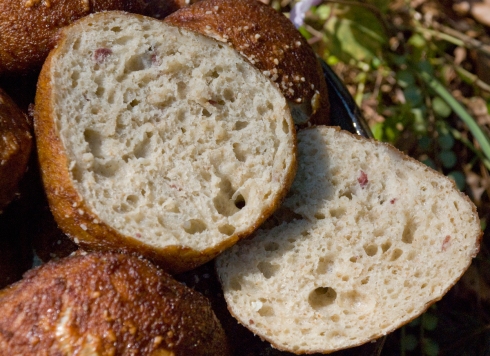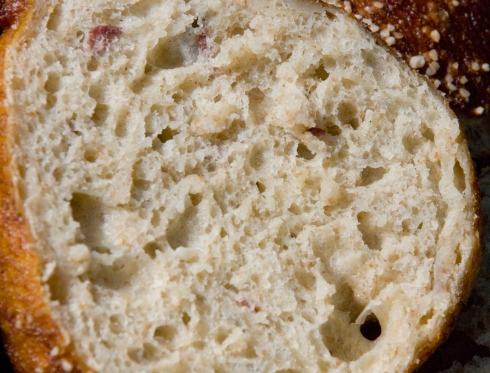I love potatoes in my bread and rolls so I figured it was time to try them in pretzel rolls. I had to make this recipe twice as the first time I didn't compensate enough for the moisture in the potatoes and the dough was way too hydrated. The rolls didn't come out the right consistency so I made them again and cut the water back and they came out perfect.
I also added a small amount of freshly ground whole rye flour to give it a little extra flavor and I do have to say these are flavorful rolls with a crazy open moist crumb. I made some turkey burgers with caramelized onions, fresh mozzarella and bacon for dinner and these held up great.
I made the rolls a little bigger to be used for burgers so instead of the 110 grams below I made them 135 grams, but feel free to adjust the size to your liking. I also made a few with fresh Parmesan cheese instead of salt just to be interesting.
Caution: When using the Lye make sure you wear gloves, long sleeves and protective eye gear. Also, never add Lye to hot water or it will bubble over and probably burn you.
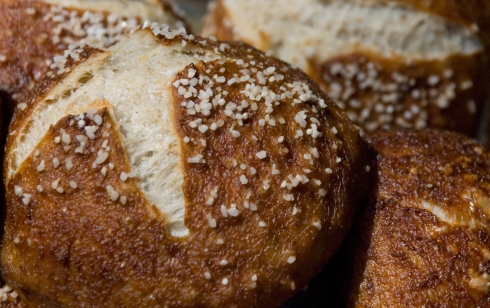
Main Dough Ingredients for 14 rolls at about 110 grams each or about 13 at 135 grams each
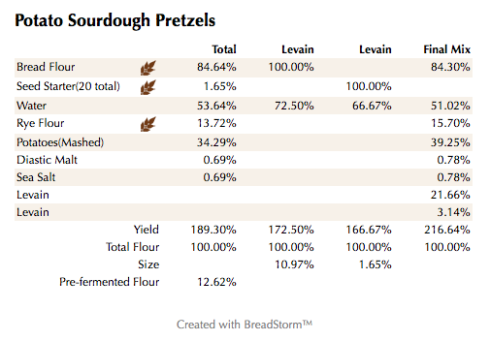
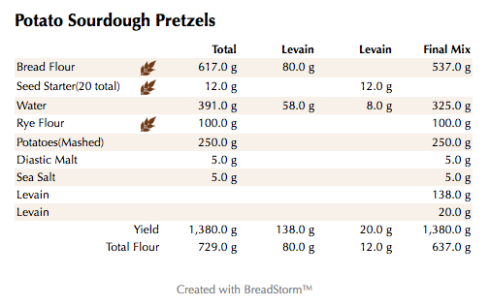

For Lye Bath (3.5% Solution
2 Liters (1836 grams) of Cold water
70 grams Sodium Hydroxide Crystals
Make the Levain
Add your seed starter (20 grams) to the indicated amount of flour and water and mix until incorporated. Cover and let sit out at room temperature of in your proofer until nice and bubbly around 6-10 hours depending on your temperature. Use immediately or refrigerate for a few days until ready to mix the main dough.
Procedure
Add the diastatic malt powder to the water and stir. Add the flours in your mixing bowl and slowly add the water mixture. Mix for about 1 minute until combined. Cut your starter in pieces and lay on top of the flour mixture and cover and let rest for 30 minutes to 1 hour so the flour can absorb the water.
Next add the salt and potatoes and mix for 6 minutes on low. Place the dough in a slightly oiled bowl and do a couple of stretch and folds. Cover the bowl and let it rest for 10-15 minutes. Do another stretch and fold in the bowl and let it rest another 10-15 minutes. Do another stretch and fold and let the dough sit out in the covered bowl for another 1.5 hours. Place the dough in the refrigerator until ready to bake the next day.
When ready to bake take the dough out and leave it covered in your bowl for 2 hours. Next divide the dough into pieces that are 110 grams each or 135 grams for larger rolls . Shape as rolls and place on a baking sheet and cover with either a moist towel or plastic wrap sprayed with cooking spray. Let it rest for around 60 minutes to about 1/2 proof.
While the rolls are proofing, fill a large stock pot with 2 liters of cold water. Measure out the Lye and slowly add it to the cold water. (DO NOT EVER ADD LYE TO HOT WATER). Cover the pot and bring it to a rolling boil and then shut off the heat.
Pre-heat your oven to 500 degrees. When the rolls are proofed sufficiently, prepare to dip them for about 15 seconds in the lye bath upside down. Let them drain on a bakers rack over a cookie tray covered with a towel or parchment paper. After draining for a minute you can transfer them to a cookie/baking sheet that has been sprayed with cooking spray. You want to use a stainless steel cooking sheet as aluminum may react with the lye and peel. Note: do not ever use parchment paper as the rolls will get stuck to the bottom. I know this from experience and I had to cut off the bottoms of half the rolls I made. I actually use my Silpat non-stick sheets which work like a charm.
When ready to bake, score each roll with an "X" on the middle and sprinkle with pretzel salt. Make sure you use pretzel salt if you want authentic rolls. As I said previously I used some fresh Parmesan in place of the salt on a few rolls and they were awesome.
Bake for about 15-20 minutes until they are golden brown and register about 200 F in the middle. Let them cool on a bakers rack until you can't wait any longer!
Note: you cannot store these in a plastic bag or covered really otherwise the salt will react with the moisture in the air and you will end up with soggy tops. I place them in a paper bag and leave it open so the air circulates.
Enjoy!
